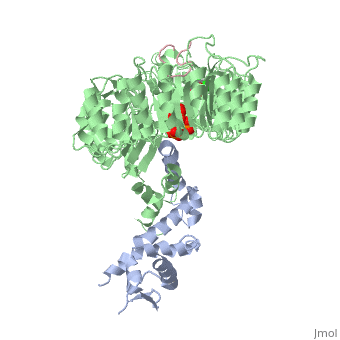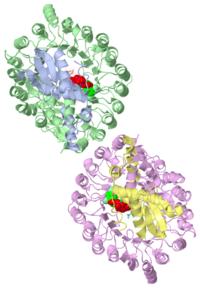Herbicide 2,4-D bound to TIR1 Ubiquitin Ligase
Overview
The structure includes the herbicide 2,4-dichlorophenoxyacetic acid (2,4-D). 2,4-D is one of the compounds used in Agent Orange, a defoliant used in the Vietnam War. It is a mimic of the phytohormone auxin, and binds in the active site of TIR1 ubiquitin ligase in a similar manner. . 2,4-D, shown here with green carbon atoms, is recognized by ARG403 (shown in blue) which forms hydrogen bonds with the acidic group. The aromatic portion of 2,4-D is recognized by a pocket composed of hydrophobic amino acids, shown in white here.
2,4-D, like auxin, promotes the association of TIR1 ubiquitin ligase with its protein substrates by acting as "molecular glue" between the molecules. This structure includes a short peptide from one of the protein substrates, shown here in pink in a or .
To see the auxin bound in the active site, look at entry 2p1q.
Publication Abstract from PubMed
Auxin is a pivotal plant hormone that controls many aspects of plant growth and development. Perceived by a small family of F-box proteins including transport inhibitor response 1 (TIR1), auxin regulates gene expression by promoting SCF ubiquitin-ligase-catalysed degradation of the Aux/IAA transcription repressors, but how the TIR1 F-box protein senses and becomes activated by auxin remains unclear. Here we present the crystal structures of the Arabidopsis TIR1-ASK1 complex, free and in complexes with three different auxin compounds and an Aux/IAA substrate peptide. These structures show that the leucine-rich repeat domain of TIR1 contains an unexpected inositol hexakisphosphate co-factor and recognizes auxin and the Aux/IAA polypeptide substrate through a single surface pocket. Anchored to the base of the TIR1 pocket, auxin binds to a partially promiscuous site, which can also accommodate various auxin analogues. Docked on top of auxin, the Aux/IAA substrate peptide occupies the rest of the TIR1 pocket and completely encloses the hormone-binding site. By filling in a hydrophobic cavity at the protein interface, auxin enhances the TIR1-substrate interactions by acting as a 'molecular glue'. Our results establish the first structural model of a plant hormone receptor.
Mechanism of auxin perception by the TIR1 ubiquitin ligase., Tan X, Calderon-Villalobos LI, Sharon M, Zheng C, Robinson CV, Estelle M, Zheng N, Nature. 2007 Apr 5;446(7136):640-5. PMID:17410169
From MEDLINE®/PubMed®, a database of the U.S. National Library of Medicine.
About this Structure
2P1N is a Protein complex structure of sequences from Arabidopsis thaliana. Full crystallographic information is available from OCA.


